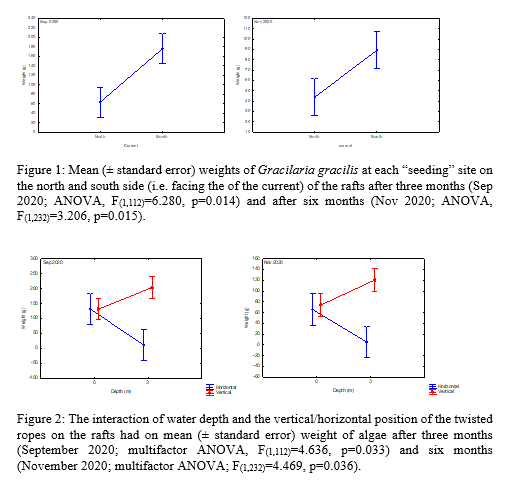DEVELOPING AN IMTA VALUE CHAIN: SEA-BASED FARMING OF MACROALGAE AND MUSSEL IN SALDANHA BAY, SOUTH AFRICA
Introduction
Commercial-scale m ussel farming is well established in Saldanha Bay, South Africa . The strong winds along the Atlantic coastline of the country , coupled with the upwelling of cold, nutrient-rich water provides the ideal condition for mussel production, within the confines of a sheltered bay. Numerous farms produce mussel in the bay , where the bivalves are seeded onto vertical twisted ropes , attached to rafts and left to filter-feed on the plankton in the bay for approximately eight months. There is already a well-established and complete value-chain for this monoculture production system .
The environmental conditions that are conducive to the filter-feeding production of mussel are also conducive to the production of various species of macroalgae; yet they are not being farmed in Saldanha Bay. The potential of culturing macroalgae, using a sea-based integrated multitrophic aquaculture (IMTA), on the existing mussel rafts had not been investigated prior to this study.
The m acroalgae take up dissolved nutrients from the water column, so they do not compete for food with the mussels, but sequester the dissolved metabolic waste of the mussel. Furthermore, the production of macroalgae on the mussel rafts would result in the more efficient utilization of the existing aquaculture facilities, making this a first attempt at sea-based IMTA- produced macroalgae and mussel in South Africa.
Materials and methods
T hree rafts in Saldanha Bay, that were already fully stocked with mussel, were loaded with additional twisted ropes that had been seeded with Gracilaria gracilis at 15 g/site along a 3.0 m rope at 40 cm intervals. The twisted ropes were placed below the rafts, either horizontally or vertically in the water column, and were positioned in the current on either the south (i.e., facing the oncoming current) or north side of the raft (i.e., with its back to the current) . After three months (September 2020) and after six months (November 2020), the ropes were lifted out of the water and approximately 80 % of the tufts of Gracilaria were removed and weighed . The remaining tufts of algae were left in their original position and the ropes were returned to the sea.
Results
T he position of the twisted ropes on the raft, in relation to the oncoming current had a significant effect on the mean weight of the seaweed, and this was the same after three and six months of growth (Figure 1). In both instances, algae on the south-side of the raft (i.e., algae that was placed in the oncoming current) was significantly larger than that on the leeward side of the raft.
Figure 1: Mean (± standard error) weights of Gracilaria gracilis at each “seeding” site on the north and south side (i.e. facing the of the current) of the rafts after three months (Sep 2020 ; ANOVA, F(1,112)=6.280, p=0.014) and after six months (Nov 2020 ; ANOVA, F(1,232)=3.206, p=0.015).
Figure 2: The interaction of water depth and the vertical/horizontal position of the twisted ropes on the rafts had on mean (± standard error) weight of algae after three months (September 2020; multifactor ANOVA, F(1,112)=4.636, p=0.033) and six months (November 2020; multifactor ANOVA; F(1,232) =4.469, p=0.036).
There was also a significant interaction between the depth that the Gracilaria were seeded and the vertical/horizontal position of the ropes in the water column (Figure 2 ). Gracilaria that was seeded just below the surface of the water grew similarly on ropes that were placed vertically and horizontally at both sampling times (Figure 2); while there was significantly more Gracilaria on the vertical ropes than that on ropes that were placed horizontal in the water column at 3.0 m below the water surface (Figure 2).
Discussion
There are currently no commercial-scale, sea-based IMTA operations in South Africa. As part of the AquaVitae (AV) project (European Union, Horizon 2020, Research Innovation Action BG2019), partners lead by Marifeed (Pty) Ltd with support from Blue Ocean Mussels (Pty) Ltd and Rhodes University, have been developing technology for the IMTA production of mussel and macroalgae in Saldanha Bay, South Africa. In this presentation, we will show the audience how we have used these data to develop this technology and we will also show how this research initiative fits into a larger program that aims to develop IMTA value chains that span the Atlantic Ocean.
This presentation will take the audience on a journey through numerous preliminary trials in which the industry and researchers together developed technology to simultaneously produce macroalgae (Gracilaria sp.) and mussels on the rafts that were originally designed for mussel production only. We will discuss what worked and where improvements were needed, and we will demonstrate how the se preliminary results have been used to design a final, commercial-scale test of this IMTA system, that is currently ongoing.
